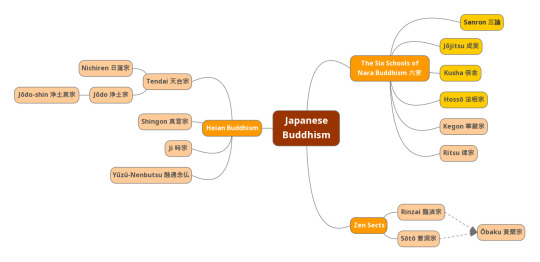Text




Now you’re just doing this on purpose to get on Harrys nerves, don’t your Draco?
4K notes
·
View notes
Text
「20代で得た知見」引用
私たちを守るものは、私たちを孤独にもする。
昨日読んだ本の感動した文章だ。何度考えても、本当にそうだよね。
他の人と親しくなりたくなくて、打ち解けない。群衆に取り囲まれるのが嫌で、必然的に人に会う機会を減らしている。
だけど、心地よい居場所を捨てれば、新しいチャンスは生まれてくるはずだ。だからこそ、いろいろなことを試して、充実した生活を送ろう。
#japanese#日本語の勉強#日本語#20代で得た知見#孤独#language learning#diary#self help#自己啓発#本#books#bookaddict#quotes#book quote
0 notes
Text
Buddhism in Japan [#2]
The first branch of Zen tradition that we will take a closer look at is the one established by Dōgen Zenji, Sōtō Zen School.
Also known as Dōgen Kigen (1200-53), he was ordained as a Buddhist monk on Mt. Hiei. At the age of 23, he left for China in search of ‘the true Way of Buddha.’ There he discovered the practice of zazen (’seated meditation’ 座禅), which became the main focus of his preaching. After coming back to Japan, he left for the mountains of Echizen, where he established in 1244 one of the two head temples of Sōtō Zen - Eiheiji. His most prominent work is ‘Shobogenzo Zuimonki’
Keizan Zenji (1268-1325) - was the 4th ancestor in the Japanese Sōtō Zen lineage. In contrast to Dōgen Zenji, whose main focus was an exploration of the internal self, Keizan Zenji looked outwards and boldly spread the teachings. He also emphasised the equality of men and women by promoting his female disciples. In 1321 he founded the second head temple Sojiji, which was moved to Yokohama after being burnt down during the Meiji period
In contrast to Rinzai Zen School, which had the support of many powerful people, including the shogunate, the Sōtō Zen School had adherents mainly among wealthy families in the rural districts
Head Temples

Eiheiji Temple (’The Temple of Eternal Peace’) - located deep in the Echizen mountains, in northwest Japan. The land was offered to Dōgen by Yoshishige Hatano, one of his most devoted lay followers. To this day, one hundred monks continue to practice his shikantaza (’single-minded seating’ 只管打坐)

Sojiji Temple - it is an internationally open temple for Zen practice located near Yokohama city. On its extensive grounds educational facilities such as a university, high school and junior high school are located. One can see how these two temple complexes differ and how both of them strive to emulate their founders’ teachings
0 notes
Text
Buddhism in Japan [#1]
I have changed my mind. I know that I have said that instalments will be chronological - and they will be - but considering that I am almost finished with ‘A Tale for the Time Being’ by Ruth Ozeki - a highly recommended read - I have decided to first study the teachings of one Dōgen Zenji, a founder of Sōtō Zen School. However, before that, it is probably beneficial to learn about Zen in general. ^^
Overall, there are twenty-two religious corporations registered with the Japanese government that are recognised as belonging to the Zen tradition, the biggest of which are Sōtō School and Rinzai School. Today we will focus on the former.
Things that all Zen branches have in common include:
Dharma transmission is said to have been founded by the Buddha Shakyamuni
Most of the branches (流派) were established during the Kamakura period (1185-1333)
They all trace their lineages back to China through two men - Nanpo Jōmyō, also known as Daiō Kokushi (1235-1308), founder of the Daiō branch of Rinzai Zen; Dōgen Kigen (1200-53), founder of the Dōgen branch of Sōtō Zen
Japanese training monasteries are modelled on the leading Buddhist monasteries of Song and Yuan Chinese dynasties
Key Concepts
Dharma transmission (傳法) - the act of designating a dharma heir
Dharma - a key concept in Buddhism and Hinduism considered to be one of the three jewels of Buddhism, alongside sangha (the Buddhist monastic order) and Buddha. When capitalised, it is understood as the collective teachings of the Buddha. Otherwise, as ‘the way things are,’ aka ‘the laws of nature.’ The earliest writings on it come from the Vedas and it was the main focus of Buddha’s mediations. It is also thought that an individual’s dharma is pre-determined
Shakyamuni - an epithet for the ‘historical’ Buddha, the founder of the Buddhist religion in the present world cycle. His image (shakazō 釈迦像) is the main object of veneration (honzon 本尊) on the central altar of most Zen monasteries and temples
#buddhism#japan#buddha#shakyamuni#zen#dogen zenji#soto zen#rinzai zen#dharma#religion#history#study#ruth ozeki#a tale for the time being
4 notes
·
View notes
Text
「進撃の巨人」第3話
有益な表現:

言えよ本当を
あんたと一緒だとは思われたくないわ
…そう言いたいのかエレン?
はあ?話聞いてたか?
頼んでねぇだろそんなことは!いつまでこんなこと続けるつもりだ?!
その話はもういいよ。仕方なかったんだから
もう何回も聞いたよ…
頭が…破裂しそうだ
すごくうなされてたけどどんな夢を?
そう照れるなよ
私も食べるから!取っといてよ!
何 謝ってんだ
オイ…そんな話してる場合か!
所持する財産は最小限に!落ち着いて避難して下さい!
さっきは『誰』に後れを取ったけど今回は負けないぜ!
ここにいたんだ!
#進撃の巨人#日本語#表現#漫画#エレン・イェーガー#アルミン・アルレルト#勉強#shingeki no kyoujin#snk#study#japanese#expressions#eren jaeger#armin arlert
2 notes
·
View notes
Text
Buddhism in Japan [SERIES]
During my year-stay in Japan I have realised that I have minimal to none knowledge on Buddhism in Japan, which is not only essential if you’re studying the culture and history of this country as an actual degree but also really helpful if you’re considering at all to sightsee all the shrines and temples.
Therefore, I have decided to explore the topic and create a ‘little’ series on it. How little will it actually be depends on how far I decide to research the subject. ^^ It will be divided into bite-size instalments, starting with a general overview and proceeding with more detailed descriptions of specific sects.
Without further ado, let’s get started!
Buddhism in Japan
There are 13 major sects that can be distinguished in Japan (peach-coloured).

Chronologically speaking, these are the Six School of Nara Buddhism, which emerged after the capital was moved to the city of Nara in 710 AD; Heian Buddhism which includes Tendai and Shingon sects from the Heian period (794-1185) and schools that branched off during the Kamakura shogunate (1185-1333) such as Jōdō or Nichiren. Lastly, there are Zen sects which also emerged around the same time.
Next instalment will cover the two main sects of the Six Schools of Nara Buddhism. ^^
1 note
·
View note
Text
「進撃の巨人」第2話

[I love him so much cx] それじゃ…
有益な表現:
あり得ない
見くびってもらっちゃ困るぜ
何やってんだよ!
章の引用
巨人は最大でも15mのはず…!50mの壁から頭を出すなんて…
でも:the て-form of です + も ‘even’. It should not be confused with the particle combination で+も, where で is a particle of location or of means.
WH-word + でも yields the following meanings:
誰でも anyone
何でも anything
いつでも any time いつでもかまいませんよ Any time will be fine
どこでも any place
どれでも no matter which it is
なんて:「XなんてY」 it is used to express criticism of X or display surprise concerning it. In contrast to なんか it can be also used after a verb or adjective, not only a noun
#進撃の巨人#漫画#リヴァイ・アッカーマン#表現#引用#勉強#日本語#でも#なんて#語彙#shingeki no kyoujin#snk#levi ackerman#manga#japanese#study#vocab#quote#expressions
8 notes
·
View notes
Text
今日の類語
自白・自供・告白・白状
秘密、罪などを自分から述べること
「使い方」
自白:全てを自白する
自供:殺人を自供する
告白:愛の告白;告白文学
白状:彼女が好きなんだろ、白状しろ
「使い分け」
自白、自供は、犯人が取り調べを受ける時に使われる語
告白は、心に思っていたことや、人に告げずにいたことを述べること
白状は、罪や隠しごとを述べることで、最も日常的に使う
2 notes
·
View notes
Text
「進撃の巨人」S1 EP14

エピソードの引用
根本的な人間性に疑問を感じざるを得ません
感じざるを得ない:「感じないわけにはいかない」という意味がある。小説や映画を見た時、実際に会った人から強烈な印象を得た時に、「感じざるを得ない」という言葉を使ってもいいです
Similarly to the construction わけにはいかない it indicates that one cannot do smth due to an external circumstance (V-inf nonpast + わけにはいかない) or that one has no other choice but to do smth (V-inf neg nonpast +わけにはいかない)
エピソードの語彙
味方:仲間、所属する側、加勢する
「例文」
味方に引き入れる win sb over/talk sb round
(戦争で)味方の国 an ally
味方の選手 a teammate
私はどちらの味方でもない I am not on either side
審議:deliberation, consideration, review
審議中である be under consideration/discussion
審議に付する refer a matter for discussion; bring a matter before the committee/Parliament
審議未了(国会で法案の)shelving a bill in the Diet
#進撃の巨人#アニメ#エレン・イェーガー#リヴァイ・アッカーマン#語彙#引用#例文#味方#審議#日本語#勉強#shingeki no kyoujin#snk#eren jaeger#levi ackerman#vocab#study#quote
1 note
·
View note
Text
「進撃の巨人」第1話
有益な表現:

長い夢を見ていた気がするんだけど…何だったっけ思い出せねぇな
急に大声出すんじゃねぇよ…
まぁ…確かにそうかもな
– 遅くったのね二人とも
– イヤ…まぁ…色々あって…
僕が言ったことを正しいと認めているから…言い返せなくて殴ることしか出来ないんだろ?
外に出たいってだけで何で白い目で見られるんだ
協力した覚えは ない
だって…危険だし…気持ちはわかるけど
#進撃の巨人#表現#有益#引用#エレン・イェーガー#ミカサ・アッカーマン#アルミン#shingeki no kyoujin#snk#eren jaeger#mikasa ackerman#armin#quotes#expressions#manga
6 notes
·
View notes
Text
今日の類語
気持ち・心持ち・心地・気分
ある物事に接して抱く心の動き
「使い方」
気持ち:あなたに対する気持ちは変わらない
心持ち:褒められて悪い心持ちになる人はいない
心地:すごいスピードで生きた心地がしなかった
気分:ウキウキした気分で出かけた
「使い分け」
気持ちは、心持ち、気分よりも感情や考えている内容を具体的に表わすことが多い。「どうしても大学に行きたい気持ち」
「気持ちがいい」「心持ちがいい」「気分がいい」とはいうが、そのいい気持ちにしてくれた対象を主語とした場合、「心持ち」「気分」は使いにくい
心地は、気分とほぼ同じように使うが、気分より文章語的である。「夢心地」寝心地」のように、他の名詞に付いて「心地」の形で使われることも多い
4 notes
·
View notes
Text
「進撃の巨人」S1 EP13
Yesterday I got back to re-watching, for the second time, all the seasons of ‘Attack on Titan.’ Join me on the ride of leafing through the new study material!

エピソードの引用
「まだまだ分からないことだらけだ」団長のエルヴィン・スミス
ーだらけ:でいっぱいである、で覆われている
「例文」
君の答案は間違いだらけだった
本はほこりだらけだった
「これまで人類が奪われてきたものに比べれば例えようもなく、小さなものかもしれん。しかし、その一歩に我々人類にとっての大きな進撃になる」ドット・ピクシス
例えようもない:incomparable, be beyond comparison
エピソードの語彙
作戦:成功のための計画
「例文」
作戦を実行に移す put a strategy into action
作戦を細かく立てる plan a strategy in detail
作戦の失敗 the miscarriage of a plan of operations
*人質奪還作戦 a hostage rescue operation
*攻勢・守勢作戦 offensive/defensive operation
*作戦勝ち a tactical victory
*作戦部隊 a task force
#進撃の巨人#リヴァイ・アッカーマン#エルヴィン・スミス#語彙#引用#作戦#例文#shingeki no kyoujin#snk#levi ackerman#levi#erwin smith#operation#vocab#quote
3 notes
·
View notes
Text
今日の類語
不運・非運・悲運
運が悪いこと
「使い方」
不運:不運にも怪我で試合に出られなかった
非運:何をやってもうまく行かず、非運に泣いた
悲運:悲運の天才画家
「使い分け」
不運は、運が悪いことを広くいうのに使う。人の力ではどうしようもないという気持ちを込めて使われることが多い。
非運は、努力しても運が開けないこと。
悲運は、悲しい運命。悲しいと判断する状況を示す言葉と一緒に使われることが多い。
*「アクセント」
悲運:ヒウン 非運:ヒウン
*「反対語」
幸運
#類語#不運#悲運#非運#反対語#幸運#勉強#日本語#japanese#study#daily vocab#vocab#synonyms#antonyms#misfortune#good fortune#dictionary
7 notes
·
View notes






